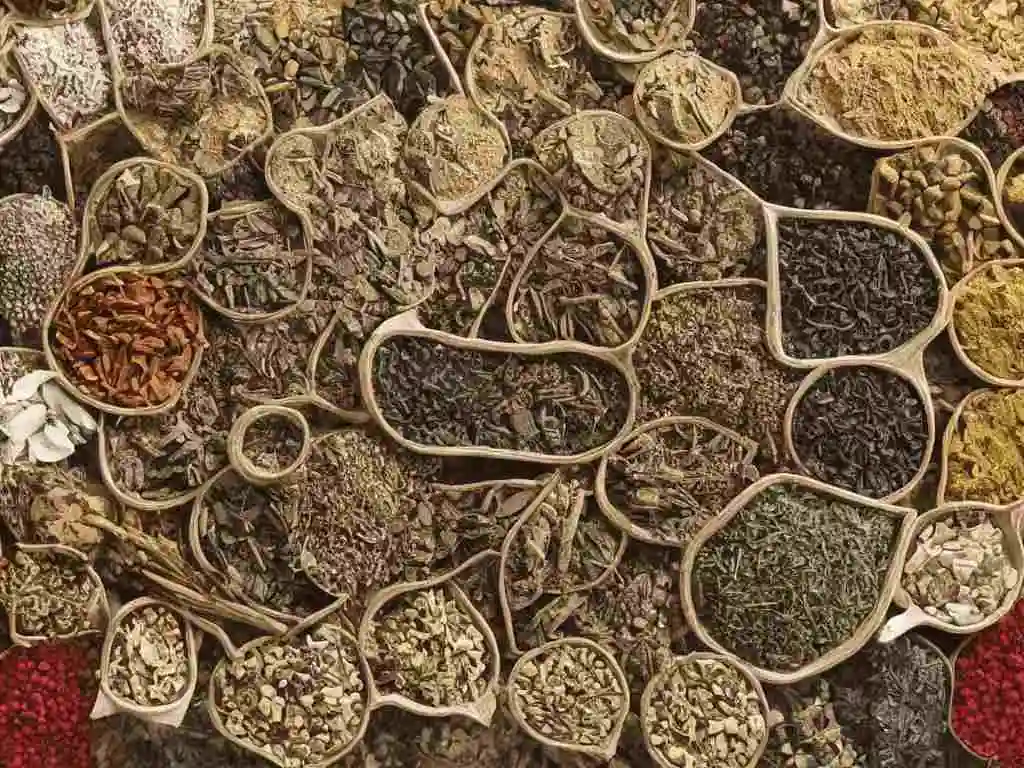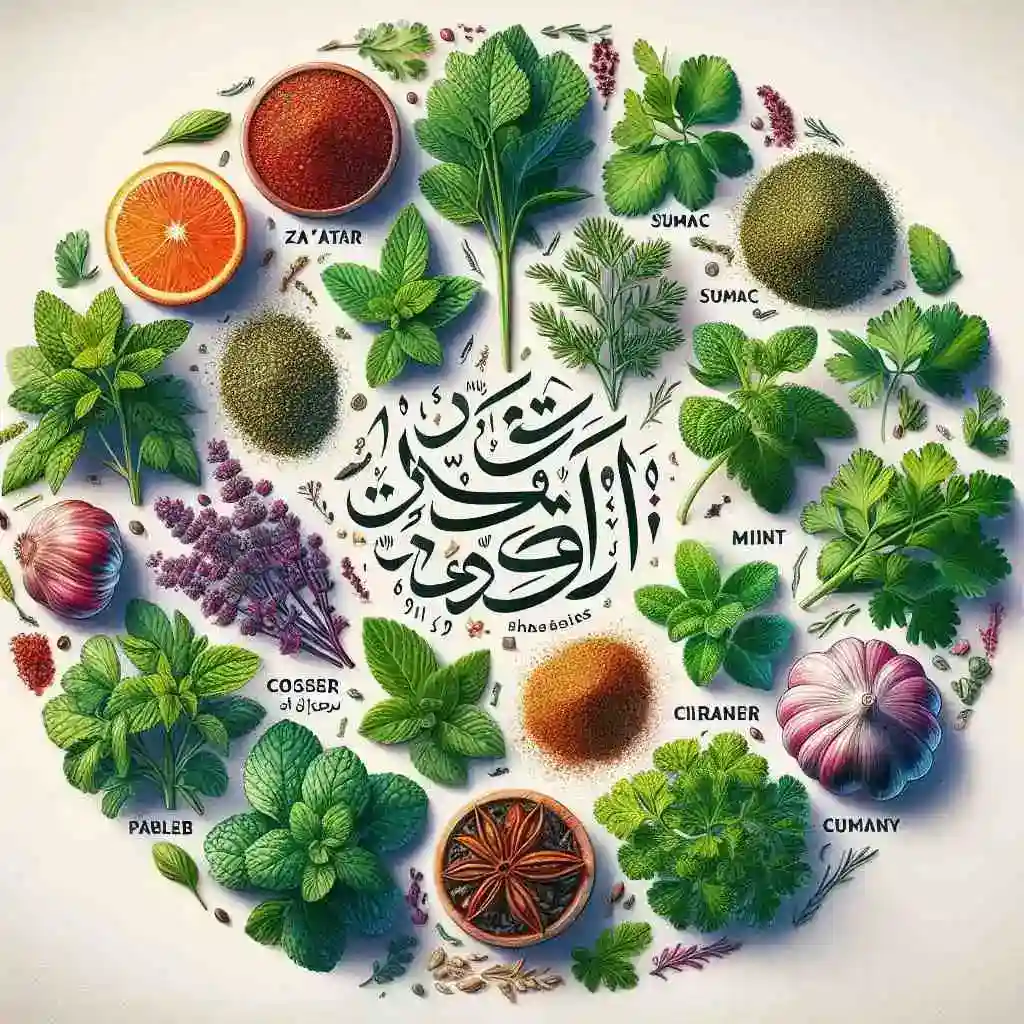Arabic cuisine is known for its delicious flavors, often thanks to the use of various herbs. Let’s explore 12 popular Arabic herbs and their culinary uses.
12 Charming Arabian Herbs: Discover the Essence of Arabia

Mint (Na’na)
Flavor Profile: Mint, known as “na’na” in Arabic, offers a refreshing and subtly sweet flavor with citrus undertones.
Culinary Uses: This versatile herb finds its way into various culinary creations, from the iconic mint tea to refreshing salads, savory dishes, and decadent desserts.
Cultural Significance: Mint holds a special place in Arab hospitality, symbolizing warmth and welcome. Mint tea, in particular, is a ubiquitous beverage served to guests as a gesture of hospitality and friendship.
Parsley (Baqdounis)
Flavor Profile: Parsley, or “baqdounis,” adds a crisp, slightly peppery, and earthy flavor to dishes.
Culinary Uses: Widely used as a garnish, parsley also plays a central role in salads, dips like tabbouleh, and as a flavor enhancer in various meat and vegetable dishes.
Cultural Significance: In Arab cuisine, parsley symbolizes vitality and freshness. Its vibrant green color adds visual appeal to dishes, making them inviting and appetizing.
Cilantro (Kuzbara)
Flavor Profile: Cilantro, known as “kuzbara,” offers a bright, citrusy flavor with a hint of pungency.
Culinary Uses: Commonly used in sauces, soups, and meat dishes, cilantro adds depth and complexity to culinary creations.
Cultural Significance: Cilantro has a long history in Middle Eastern cuisine and is believed to bring good fortune and health. Its aromatic leaves are prized for their flavor-enhancing properties.
Thyme (Za’atar)
Flavor Profile: Thyme, or “za’atar,” is characterized by its earthy aroma and subtle floral notes.
Culinary Uses: A key ingredient in the za’atar spice blend, thyme is used to season bread, meats, and vegetables, imparting a distinctive flavor.
Cultural Significance: Za’atar holds cultural significance in Arab cuisine, symbolizing the essence of the land and tradition. It is often enjoyed as a condiment with olive oil and bread.
Sage (Maramia)
Flavor Profile: Sage, or “maramia,” offers a warm, peppery flavor with slight bitterness.
Culinary Uses: Sage enhances the flavor of meats, stuffing, and savory dishes, adding depth and aroma.
Cultural Significance: Revered for its medicinal properties, sage is believed to bring wisdom and protection in Arab culture. It is also used in traditional herbal remedies for its therapeutic benefits.
Rosemary (Azza’atar)
Flavor Profile: Rosemary, or “azza’atar,” has a woody, pine-like flavor with mild bitterness.
Culinary Uses: Rosemary is perfect for seasoning roasted meats, potatoes, and bread, adding depth and complexity to dishes.
Cultural Significance: Symbolizing remembrance and loyalty, rosemary is often used in festive dishes and special occasions, adding a touch of tradition to culinary celebrations.
Dill (Shabat)
Flavor Profile: Dill, or “shabat,” offers a tangy flavor with subtle sweetness.
Culinary Uses: Dill enhances the flavor of seafood, salads, and yogurt-based dishes, offering a burst of freshness.
Cultural Significance: Associated with prosperity and new beginnings, dill is often included in dishes served during weddings and celebrations, symbolizing hope for the future.
Oregano (Za’tar Faransi)
Flavor Profile: Oregano, known as “za’tar faransi,” is robust and aromatic.
Culinary Uses: Oregano adds depth to sauces, marinades, and grilled meats, infusing dishes with Mediterranean flair.
Cultural Significance: Celebrated for its culinary versatility and healing properties, oregano is used in both savory dishes and herbal remedies in Arab culture.
Bay Leaves (Ward Ghar)
Flavor Profile: Bay leaves, or “ward ghar,” have a subtle, floral flavor.
Culinary Uses: Essential in soups, stews, and sauces, bay leaves impart a delicate aroma and flavor.
Cultural Significance: Symbolizing victory and protection, bay leaves are often used in traditional Arabic dishes to ward off evil spirits and bring good fortune.
Coriander Seeds (Kuzbara Habb)
Flavor Profile: Coriander seeds, or “kuzbara habb,” have a warm, citrusy flavor.
Culinary Uses: Ground coriander enhances spice blends, curries, and pickles, offering a hint of citrus.
Cultural Significance: Believed to aid digestion and promote vitality, coriander seeds are used in both cooking and herbal remedies in Arab culture.
Saffron (Za’faran)
Flavor Profile: Saffron, or “za’faran,” is floral with a subtle honey-like sweetness.
Culinary Uses: Saffron adds a golden hue and distinctive flavor to rice dishes, desserts, and teas, elevating them to gourmet status.
Cultural Significance: Treasured for its rarity and beauty, saffron symbolizes wealth, prosperity, and hospitality in Arabic culture.
Sumac (Summaq)
Flavor Profile: Sumac, or “summaq,” is tart and tangy.
Culinary Uses: Sprinkled over salads, grilled meats, and dips, sumac adds a zesty pop of flavor.
Cultural Significance: Celebrated for its vibrant red color and citrusy taste, sumac has been a culinary staple in the Middle East for centuries, adding brightness and depth to dishes.
Arabic herbs are not just ingredients; they are an integral part of the culinary heritage of the Middle East. From the refreshing mint to the earthy thyme and tangy sumac, each herb brings its own unique flavor and cultural significance to the table.
Whether you’re savoring a traditional dish or experimenting with new flavors, incorporating Arabic herbs into your cooking will undoubtedly elevate your culinary journey to new heights. So, embrace the rich diversity of Arabic herbs and let them add depth, aroma, and authenticity to your dishes.
Arabic Herbs and Their Medicinal Properties
| Herb | Arabic Name | Medicinal Properties | Traditional Uses |
|---|---|---|---|
| Mint | Na’na | Antioxidant, Digestive Aid, Stress Relief | Soothes Digestive Issues, Relieves Headaches, Improves Respiratory Health |
| Parsley | Baqdounis | Anti-inflammatory, Diuretic, Immune Booster | Detoxifies the Body, Supports Kidney Health, Enhances Immunity |
| Cilantro | Kuzbara | Detoxifying, Antimicrobial, Antioxidant | Cleanses the Body, Fights Infections, Lowers Blood Sugar |
| Thyme | Za’atar | Antibacterial, Antifungal, Antioxidant | Boosts Immunity, Treats Respiratory Infections, Supports Digestive Health |
| Sage | Maramia | Anti-inflammatory, Antioxidant, Memory Enhancer | Improves Cognitive Function, Relieves Menopausal Symptoms, Supports Oral Health |
| Rosemary | Azza’atar | Anti-inflammatory, Antimicrobial, Antioxidant | Boosts Circulation, Enhances Memory, Promotes Hair Growth |
| Dill | Shabat | Digestive Aid, Antimicrobial, Antispasmodic | Relieves Gas and Bloating, Supports Bone Health, Eases Menstrual Cramps |
| Oregano | Za’tar Faransi | Antibacterial, Antiviral, Antioxidant | Fights Infections, Supports Heart Health, Reduces Inflammation |
| Bay Leaves | Ward Ghar | Anti-inflammatory, Digestive Aid, Stress Relief | Eases Digestive Discomfort, Relieves Joint Pain, Calms Anxiety |
| Coriander Seeds | Kuzbara Habb | Digestive Aid, Antioxidant, Cholesterol-lowering | Aids Digestion, Reduces Blood Sugar, Lowers Cholesterol |
| Saffron | Za’faran | Antioxidant, Mood Enhancer, Aphrodisiac | Elevates Mood, Improves Sleep, Enhances Libido |
| Sumac | Summaq | Antioxidant, Anti-inflammatory, Digestive Aid | Supports Heart Health, Relieves Arthritis Pain, Enhances Digestion |



